The Microsoft Surface Book 3 (15-Inch) Review: A Refreshing Dip Into Ice Lake
by Brett Howse on June 3, 2020 9:00 AM ESTBattery Life
One of the advantages of the Surface Book design is that it offers up a significant amount of space for battery cells, with around 22 Wh in the tablet, and another 63 Wh in the base, adding up to 85 Wh total capacity. But battery capacity is only part of the equation, with platform efficiency also being as important.
To test the battery life of the Surface Book 3, the display was set to 200 nits, and the total time was measured to discharge a 100% charged device in a couple of scenarios. We’ve dropped our old light test, since the workload was almost an idle time for modern devices, and will now be testing our heavy web workload, movie playback, and new to this review, the PCMark 10 Modern Office Battery life test.
Web Battery
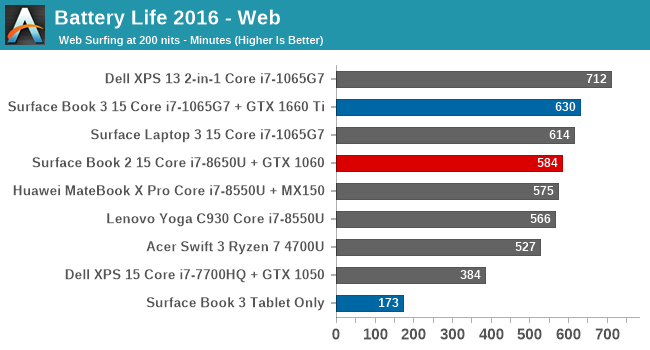
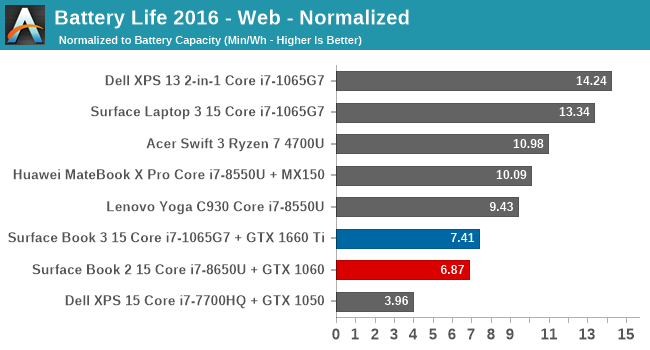
The extra battery capacity certainly helps the Surface Book 3 maintain all-day battery life. Despite the large, high-resolution display, the Surface Book 3 offers particularly good battery life at 10.5 hours on this test. It achieved 46 minutes more runtime than the Surface Book 2, and since they both share the same display, likely points to the efficiency gains of the new Ice Lake processor under load. There are devices that can achieve longer battery life, but since so much of the power draw is the display, they tend to have much lower power 1920x1080 offerings.
Movie Playback
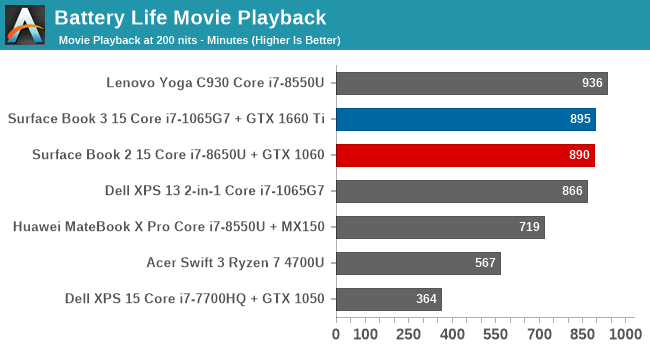
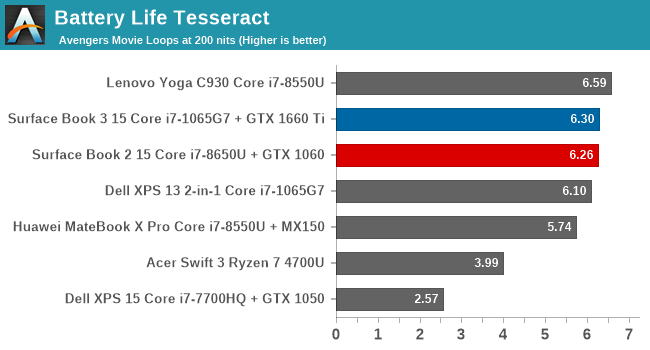
Movie playback tends to be one of the best ways to achieve battery life, since the video decode is offloaded to fixed-function hardware in the media block which can be very efficient. The Surface Book 3 achieves almost 15 hours of battery life in this test, outperforming the previous model by five minutes. Very impressive.
PCMark 10 Modern Office
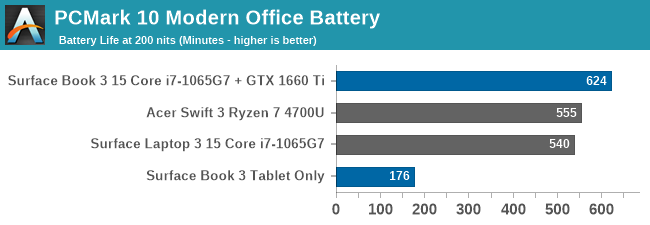
Adding in a new test means we unfortunately don’t have the backlog of data from previous devices, so for now please accept this smaller comparison. The large battery once again does what it intended, offering almost 10.5 hours here as well. The Modern Office battery test runs three scenarios, each at ten minutes in length. If a device finishes the test sooner, it will idle until the ten minutes is up, so faster devices will be able to get into the “hurry up and wait” stage which should be a benefit in this test.
Platform Power
The big 15-inch high-resolution display accounts for a big chunk of the Surface Book 3's power draw. With the display at the same 200 nits brightness we test at, measured power draw of the system was around 6.5 Watts, but with the display off, idle power draw dropped to as low as 650 mW, which is very impressive. Microsoft has certainly done their homework. That means the display accounts for almost six watts of draw at 200 nits. High DPI has its price, and that is battery life.
Also of note, the Surface Book 3 will disable the discrete GPU if the battery falls below a certain percentage, which seems to be around 8-10% charge. This was confirmed as by-design, and the NVIDIA GPU will no longer show up in device manager until the device is charged and rebootted.
Charge Time
Microsoft includes a 127-Watt AC adapter with the new Surface Book 3, which will prevent it from discharging under load like the previous model could, but as with most devices, the amount of power you put into the battery is never that high. If you need to charge the laptop on the go, it can also be charged over the USB-C connector, although you won’t achieve the power provided by the included adapter.

Interestingly, with the batteries split into two sections, you would think Microsoft would be able to charge the Surface Book quicker than most other devices, but they are pretty conservative with the power going back into the battery, likely to increase battery longevity. As such, charging from empty still takes over 2.5 hours.










125 Comments
View All Comments
Icehawk - Wednesday, June 3, 2020 - link
And don’t forget if they drain the battery you can’t plug them into a dock to turn it on, you need to use a standalone charger to get it up to 10% or so first. Ugh I am not a Surface fan AT ALL. I’ve supported almost all of the models.pjcamp - Wednesday, June 3, 2020 - link
I don't give a crap about bezels and I doubt anyone else does either, beyond tech pundits and reviewers who need something trendy to criticize. In fact, for devices to be held in the hands, like phones and tablets, bezels are a feature, not a bug, as they limit accidental activations.I own an original Surface Book, and I have a few observations about its durability.
In the end, the detachable form factor is not a good idea. It means if you want to get inside, you have to pry off the screen, a dicey proposition. It is fussy and fumbly to switch back and forth, which you really need to do if you need to change between drawing and typing as drawing in laptop mode is made quite difficult by the screen wobbling back and forth. It's best to think of this as a pure laptop.
The build quality is suspect. I've actually owned three of these things due to warranty replacements. Each of the previous ones had a power button that got stuck in the on position.
Also, I don't detach the screen very much, but the connection on all three computers became wonky. Suddenly it no longer sees the keyboard any more and announces that it is in tablet mode.
The memory wire attachment mechanism is clever, but it has gotten to the point that it doesn't work consistently. And the only recourse then is to find the one and only vent hole on the side that allows you to push a paper clip in at a 45 degree angle to force a manual release. That is clearly designed to prevent you from using it.
Batteries are not eternal but at this point my battery life with keyboard attached is down to less than two hours. That seems like an awfully quick degradation, as these things go.
The only thing that is an unmitigated good about these device, and it is a big thing, is the hi res 3:2 screen. If only Microsoft could make Windows scale appropriately instead of relying on each app to do it independently.
Spunjji - Thursday, June 4, 2020 - link
This pretty much summarises my understanding of the devices, from a support perspective... they're just fussy. Over-engineered would be another way of putting it. Impossible to repair, fragile, and generally not suited to regular use "in anger".A damn shame, really, as I like the concept.
Deicidium369 - Friday, June 5, 2020 - link
I am not sure about them being fragile - have had 10 or 11 deployed in the field, and they can at times take a beating - no failures in ~2 years - I have had my older model for going on 4, although doesn't get used that much anymore... still no issues.Spunjji - Friday, June 5, 2020 - link
Your ~11 beats my 2, but of those 2 both failed - and one had intermittent GPU driver issues even when it was working.amb9800 - Wednesday, June 3, 2020 - link
The GTX 1660 Ti Max-Q seems to be delivering better performance than expected (especially given it's a 65W part, vs. the 80W GTX 1060 Max-P in the Surface Book 2 15"), so it's not a completely worthless spec bump.That said, this would've been the perfect use case for the Ryzen 4000 U-series CPUs. Equipping the Surface Book 3 with a Ryzen 7 4800U would've allowed for performance on par with 45W 6/8-core Intel-based 15" competitors but within the Surface's 15-25W TDP budget.
Intel Ice Lake U-series is by far the biggest disappointment on this machine -- it (along with every other premium Intel-powered ultrabook) gets destroyed by the 4700U-powered $650 Acer Swift 3. The performance picture gets even worse when you look at, say, the Asus ROG Zephyrus G14, which ups the ante with the desktop-killing Ryzen 9 4900HS for under $1,500 -- with a 14" screen, solid battery life, and lower weight than even the 13" Surface Book 3.
lmcd - Thursday, June 4, 2020 - link
It's completely idiotic to compare a part that fits in a tablet form factor with a laptop sporting a 35W CPU. Whether the form factor is dumb or not is a different question.Worth remembering that Intel has delivered a "true SoC" platform for quite some time now. AMD's past CPUs, by comparison, weren't "true SoC" platforms and weren't even candidates to fit on this size of board. Ryzen 2x00U had an idle power bug across the platform, further removing it from candidacy.
That means the first AMD SoC the Surface Book team might've had the chance to integrate is the 3x00U. Based on how long it took for MS to integrate Ice Lake, the Surface Book 3 wouldn't get the 4700U until Christmas or later. Possibly longer considering that the 4700U is a more substantial change than Ice Lake vs past Intel SoCs.
lmcd - Thursday, June 4, 2020 - link
Yea just found this from the Renoir intro:"AMD’s latest Ryzen mobile product is the first design the company has done that combines CPU, GPU, and IO all on a monolithic die in TSMC’s 7nm process."
Indicating that IO wasn't entirely on-board before. Surface Book 4 could theoretically have a Ryzen design.
Deicidium369 - Friday, June 5, 2020 - link
Would imagine that the 1 AMD design they have would be sporting the 4000 series - wonder how much of a new design was needed to support it. Thermals would be better on the 4000 vs the older designSpunjji - Friday, June 5, 2020 - link
I think you've misinterpreted that - Renoir is the first AMD SoC that combines all of that *on 7nm*. I'm fairly sure Raven ridge included USB, SATA etc on-die - that's how the A300 Promontory "chipset" in the ASRock A300 does its thing.Wouldn't surprise me if the SoC had a larger package area than the Intel competitors, though. Intel have been working hard on that aspect for a few generations now.